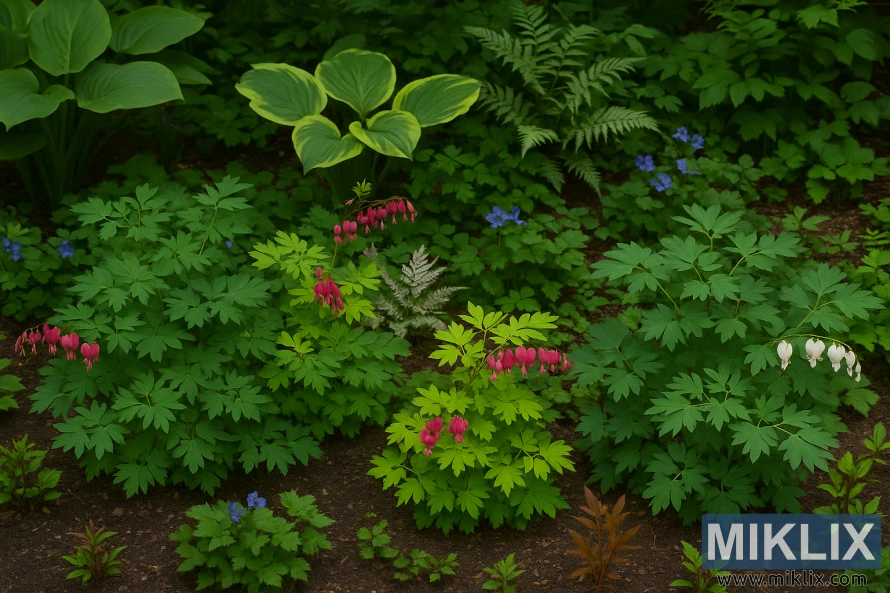Image: Mixed Shade Garden with Bleeding Heart Varieties and Companion Plants
Published: October 29, 2025 at 10:11:28 PM UTC
A serene high-resolution photo of a mixed shade garden showcasing pink, white, and rose Bleeding Hearts with hostas, ferns, and companion plants, captured in gentle dappled light.
This high-resolution landscape photograph depicts a beautifully balanced mixed shade garden, alive with texture, color, and form. The focal point of the composition is a trio of Bleeding Heart (Dicentra) varieties in full bloom—each radiating distinct hues that harmonize elegantly with the surrounding foliage. On the left, a traditional Dicentra spectabilis displays pendulous, deep pink heart-shaped flowers along gracefully arching stems. In the center, a golden-leaved Bleeding Heart cultivar shines vibrantly, its chartreuse foliage contrasting with the rich magenta blossoms that dangle delicately like living jewels. To the right, the soft white blooms of a pure Dicentra alba variety complete the color progression, their translucent petals glowing subtly in the filtered light.
The plants are arranged naturally, yet intentionally, forming a tapestry of texture and tone that feels both wild and refined. Beneath and around the Dicentra, the soil is covered with a fine, dark layer of mulch that highlights the saturated greens of the leaves above. Companion plants fill the garden’s understory with lush variety: large, broad Hosta leaves with deep emerald and variegated yellow centers anchor the back of the composition, while the lacy fronds of a Japanese Painted Fern lend a feathery contrast. Scattered between these structural plants are splashes of violet-blue from hardy Geraniums (Cranesbill), their small blooms adding cool, understated accents amid the greenery.
The overall light in the photograph is soft and diffuse, typical of a shaded woodland garden. Gentle dapples of sunlight filter through the overhead canopy, touching select leaves and petals with a quiet shimmer. This interplay of light and shadow enhances the natural depth of the scene, emphasizing the curves of the arching stems, the veining of the Hosta leaves, and the tender translucence of each flower. The air of calm and balance pervades the image, evoking the serenity of a sheltered woodland glade on a late spring morning.
Compositionally, the image demonstrates masterful visual balance. The arrangement of plants moves rhythmically across the frame—anchored by the Hosta and fern in the background, punctuated by the Bleeding Hearts in mid-ground bloom, and softened by low-growing foliage and emerging perennials at the front. Each element contributes to a layered depth that draws the viewer’s eye from one textural vignette to another.
The mood of the scene is tranquil, restorative, and deeply organic. The Bleeding Hearts, with their gracefully pendulous blossoms, symbolize affection and emotional connection, while the companion plants ground the composition with a sense of resilience and perennial beauty. Together, they form a visual ode to the quiet artistry of shade gardening—a celebration of subtle color harmonies, contrasting textures, and the rhythm of growth beneath the trees.
This photograph transcends simple documentation; it is a living portrait of garden design at its finest. Every plant appears thoughtfully placed yet wholly natural, illustrating how cultivated order and wild spontaneity can coexist. It captures the essence of a temperate woodland garden: cool, lush, and endlessly serene—a timeless refuge where nature and nurture merge seamlessly into one harmonious whole.
The image is related to: A Guide to the Most Beautiful Varieties of Bleeding Heart to Grow in Your Garden

